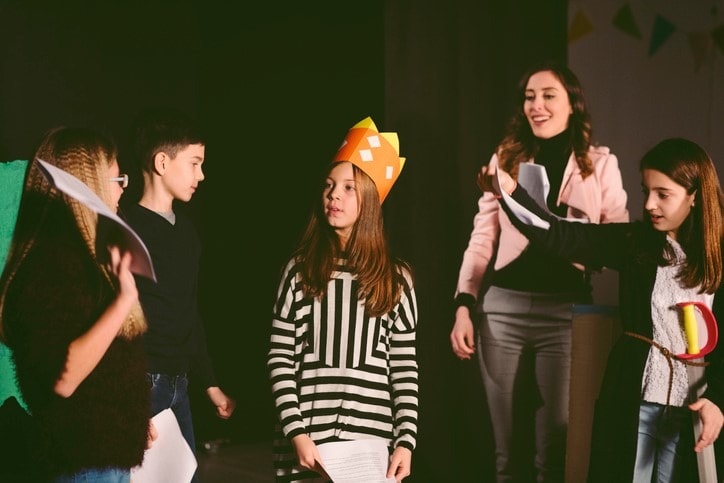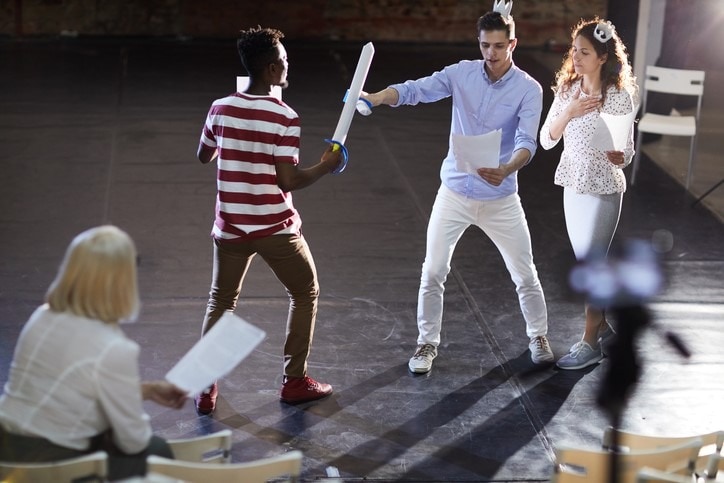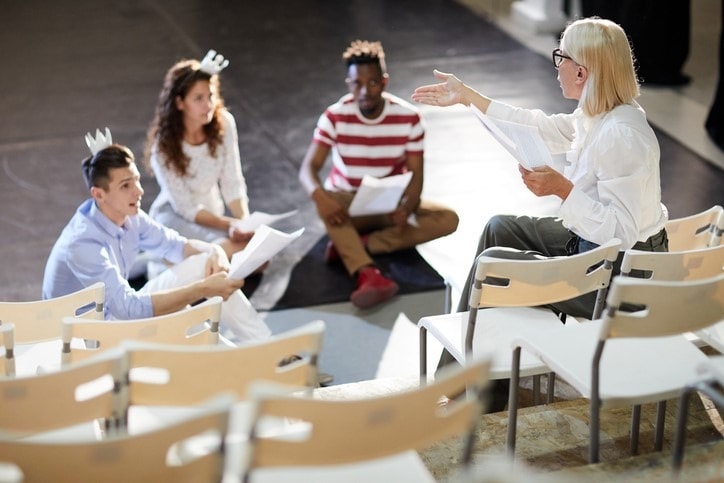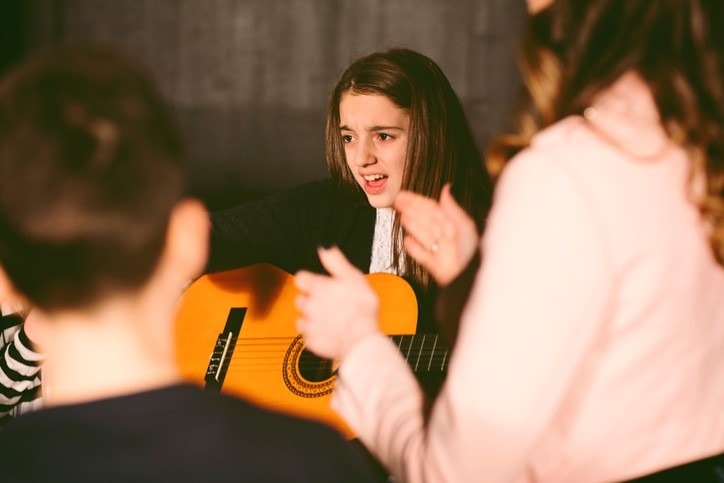NAfME BLOG
Creative Opportunities for Integrating Opera and Theatre into Your Music Class

/ News Posts / Creative Opportunities for Integrating Opera and Theatre into Your Music Class
Let Them Play!
Creative Opportunities for Integrating Opera and Theatre into Your Music Class
By NAfME Member Stephanie Ruggles, sponsored by Opera Theatre of Saint Louis
Kids love to play. And not just the little ones! The big kids love it too. Creative play allows for exploration of ideas, building empathy, new perspectives, and true awareness of one’s environment. Often, throughout the school year, looming concert deadlines and standardized testing make it easy to forget to schedule the time for our students to engage in creative activities. Add a pandemic to the mix and the challenges increase exponentially.
In this article, I will talk about using opera and theatre elements to “Let them play!” I will also describe how to set up your class to create and produce its own mini-musical/operatic work. These ideas come from many years of classroom experience, collaboration with other teachers, and are inspired by training through Music! Words! Opera! provided by Opera Theatre of Saint Louis.
What are the benefits of incorporating such a unit?
- Rigor—this unit encompasses all Anchor Standards within the National Core Arts Standards.
- Relevance—though the process is teacher-facilitated, the students are in charge of their story and how they choose to tell their story through various elements and genres of music, theatre, and visual arts. This unit is responsive to the cultures of the students in your classroom.
- Engagement—all participants are stakeholders, student voice and choice are recognized and validated.
- Opportunities for Arts Integration in typically non-arts based classrooms—team up with your math, ELA, science, and social studies teachers while keeping music and other art forms for their own sake in your classroom.
- Adaptable for all learning situations: in-person, hybrid, and virtual
- The students get to play while doing some very important work!
Before we can play, we must know what’s involved.
- Set the classroom culture. Creativity relies on vulnerability. Hold a class meeting and set expectations, but also invite your students to help with setting class agreements and norms. For example: Everyone contributes and participates. We respectfully listen to all ideas. Everyone takes part in the music portion whether they are composers, singers, or instrumentalists. This is also a great time to reflect individually on students’ personal strengths and talents (both musical and non-musical).
- Build community with your class using musical and theatrical improvisation games and activities.
- Introduce the art form/history and view examples—What is opera? What is a musical?
- Choose a high-quality filmed production to view as a class.
- Dissect the story as a class: What happened in the beginning? Middle? End? What was the conflict? How was it resolved or left unresolved? How did the music drive the plot or describe each of the characters? What questions came up as you watched the production?
- Decide how you will create your story concept: Will it be based on an existing story? Could we use some of our questions we asked while viewing (i.e. What ever happened to that character? Why is that character sad/happy/mad all of the time? What if the main character had made a different choice? What happened before we met the characters?)? Do we want to create an original story using writing prompts?
- Create a story outline with the whole group. Depending on class size, you may divide into smaller groups and have each group create their own and then agree on the story as a class.
- Come up with a list of items you will need to build your production (music notation software, DAWS, art supplies, fabric, etc.)
- Decide how to manage your time. Set your production date and plan backwards to ensure you know when creation starts and rehearsal/production begins.
- Move into groups and start the creation process. All groups must communicate with one another throughout the creation process.
- Composers/Lyricists
- Script writers
- Choreographers
- Prop Designers and makers
- Set designers
- Costume designers
When facilitating this type of project, I let students gravitate towards the groups they feel they can contribute to best. I also let students move from group to group if they decide their strengths and talents are needed somewhere else. However, they must finish their current task in order to move elsewhere, so as not to leave their group mates in a bind.
The biggest moments of joy, aside from the pride that students show in their performance, occur during these weeks of buzzing about the classroom creating. It may be that the class is circled up playing an improv game. Sometimes there are impromptu fashion shows showing off the costume creations. Other times, we’re sharing original compositions with one another or asking each other for feedback on the development of our script. Or, it’s a group of students deciding on the rhythm pattern of the words while writing lyrics, which sparks great conversation about words that rhyme and are interesting to the story. Students start leading their own music rehearsals. Work becomes play, and this particular type of creative play accomplishes the work.
Moving into rehearsal and production.
In this stage, the following must happen:
- Casting decisions are made—remember that everyone sings or plays an instrument in the final production
- Students assume crew responsibilities to move the production along (props master, stage hands when not part of a scene, etc.)
- Plan the blocking
- Put it all together and rehearse!
- Perform for an audience—this could be during school hours for another classroom, or included in a public performance or concert.
- Whole class and individual reflection of the performance
How does one assess this type of project?
In my classroom, we used a formative assessment sheet that asked, “What did you accomplish today? What do you plan to accomplish tomorrow?” Students self-rate their level of contribution to each work session using a rubric. For the performance itself, students write a reflection and are graded with a performance rubric.
Imagine the unique possibilities each of your students will contribute to a project like this! It’s time to let them play!
About the author:
 NAfME member Stephanie Ruggles has taught choir for 18 years at Ritenour Middle School in the Saint Louis area and is a former Middle School Choral Co-Vice President for the Saint Louis Suburban Music Educators Association. She holds a Bachelor of Music Education from the University of Missouri—Saint Louis and a Master of Music in Vocal Performance from Washington University. In 2017, she became the Program Director of the Opera Camp for Kids! for Opera Theatre of Saint Louis, where she previously taught for several years. In addition to being an educator, she maintains a performance career as a Contralto, performing in both concert and operatic settings.
NAfME member Stephanie Ruggles has taught choir for 18 years at Ritenour Middle School in the Saint Louis area and is a former Middle School Choral Co-Vice President for the Saint Louis Suburban Music Educators Association. She holds a Bachelor of Music Education from the University of Missouri—Saint Louis and a Master of Music in Vocal Performance from Washington University. In 2017, she became the Program Director of the Opera Camp for Kids! for Opera Theatre of Saint Louis, where she previously taught for several years. In addition to being an educator, she maintains a performance career as a Contralto, performing in both concert and operatic settings.
Interested in reprinting this article? Please review the reprint guidelines.
The National Association for Music Education (NAfME) provides a number of forums for the sharing of information and opinion, including blogs and postings on our website, articles and columns in our magazines and journals, and postings to our Amplify member portal. Unless specifically noted, the views expressed in these media do not necessarily represent the policy or views of the Association, its officers, or its employees.
February 19, 2021. © National Association for Music Education (NAfME.org)
Published Date
February 19, 2021
Category
- Standards
Copyright
February 19, 2021. © National Association for Music Education (NAfME.org)






